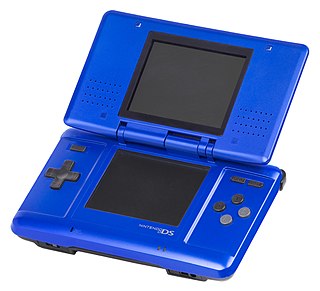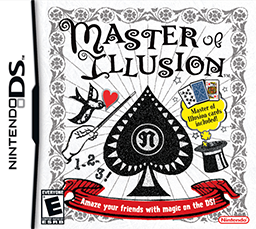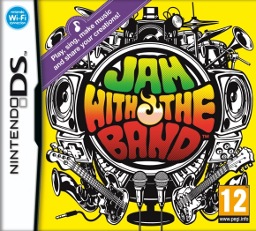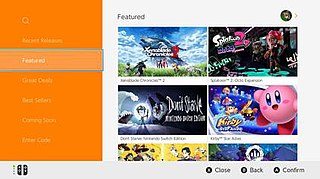
The Nintendo DS is a foldable handheld game console produced by Nintendo, released globally across 2004 and 2005. The DS, an initialism for "Developers' System" or "Dual Screen", introduced distinctive new features to handheld games: two LCD screens working in tandem, a built-in microphone and support for wireless connectivity. Both screens are encompassed within a clamshell design similar to the Game Boy Advance SP. The Nintendo DS also features the ability for multiple DS consoles to directly interact with each other over Wi-Fi within a short range without the need to connect to an existing wireless network. Alternatively, they could interact online using the now-defunct Nintendo Wi-Fi Connection service. Its main competitor was Sony's PlayStation Portable during the seventh generation of video game consoles.

Nintendo Wi-Fi Connection is a defunct online multiplayer gaming service run by Nintendo that formerly provided free online play in compatible Nintendo DS and Wii games. The service included the company's Wii Shop Channel and DSi Shop game download services. It also ran features for the Wii and Nintendo DS systems.

The Nintendo DS Lite is a foldable handheld game console developed and manufactured by Nintendo. It is the second iteration of the Nintendo DS and is slimmer, brighter, and more lightweight than the original. It was announced on January 26, 2006, more than a month before its initial release in Japan on March 2, 2006 due to overwhelming demand for the original model. It has been released in Australia, North America, Europe, New Zealand, Singapore, and defined regions in South America, the Middle East, and East Asia. As of March 31, 2014, the DS Lite had shipped 93.86 million units worldwide.

Brain Age 2: More Training in Minutes a Day!, known as More Brain Training from Dr Kawashima: How Old Is Your Brain? in PAL regions, is an edutainment puzzle game and the sequel to Brain Age: Train Your Brain in Minutes a Day! (2005). It was developed and published by Nintendo for the Nintendo DS handheld game console. Before the game begins, the player must perform a Brain Age Check to determine their brain age, which ranges from 20 to 80, to determine approximately their brain's responsiveness. A brain age of 20, the lowest age that the player can achieve, indicates that the player's brain is as responsive as that of an average 20-year-old. After the player is told their initial brain age, they can complete a series of minigames to help improve their brain's responsiveness, after which they can run Brain Age Check again to determine their updated brain age.

Vanpool, Inc. was an independent Japanese video game, music software, computer software and toy developer. Its employees included Taro Kudou and Kazuyuki Kurashima, both of whom worked for the independent game developer Love-de-Lic. The company was primarily known for its work on the Dillon's Rolling Western and Kirby series. Vanpool shut down on May 31, 2023.

Master of Illusion, known in Europe as Magic Made Fun: Perform Tricks That Will Amaze Your Friends! and in Japan as Magic Encyclopedia, is a magician video game for the Nintendo DS. It was developed by Tenyo and Eighting and published by Nintendo, released in Japan on November 16, 2006, November 26, 2007 in North America and March 14, 2008 in Europe. Around 9 of its magic tricks were released as separate pieces of DSiWare.

Jam with the Band, known in Japan as Daigasso! Band Brothers DX, is a music video game developed and published by Nintendo for the Nintendo DS handheld game console. It is the sequel to the Japan-exclusive Daigasso! Band Brothers, which was released at the DS' launch. Jam with the Band was released in Japan in June 2008 and in Europe in May 2010. It uses the largest save capacity for a Nintendo DS game at eight megabytes. Its release was accompanied by a Wii Channel for the Wii console called the Live Channel, known in Japan as the Speaker Channel, that allows players to hear the game's sound through their television. It features the character Barbara Bat, who was also in the predecessor.

Littlest Pet Shop is a video game of the Littlest Pet Shop franchise for Microsoft Windows, Wii, and DSiWare. The game was released in North America on October 14, 2008. A second version was released on October 20, 2009, followed by a third version released on October 5, 2010.

Picopict, known as Pictobits in North America and as Pictopict in Australia, is a puzzle video game developed by Skip Ltd. and published by Nintendo for the Nintendo DSi's DSiWare digital distribution service. It is one of seven games released for the DSi's Art Style series of video games. It was announced on January 26, 2009, was released two days later alongside Somnium, another Art Style game, and was released in North America and PAL regions in the same year, on May 18 and May 22 respectively. In Picopict, players use the touchscreen to move coloured blocks into a formation, such as a four-block line or a 2x2 square. This contributes to an 8-bit image, which consist of various Nintendo Entertainment System (NES) characters, such as Mario, Link, and Bowser.

Mario & Sonic at the Olympic Winter Games is a 2009 sports and party game developed by Sega. Like its predecessor, it was published by Nintendo for Japan and Korea and by Sega in the Western world. The game is officially licensed by the International Olympic Committee (IOC) through exclusive license International Sports Multimedia. The game is the third official crossover title to feature characters from both Mario and Sonic's respective universes, the first and second being the game's predecessor Mario & Sonic at the Olympic Games and Super Smash Bros. Brawl respectively. It was released on the Wii and the Nintendo DS in October 2009, and is the first official video game of the 2010 Winter Olympic Games.

Mighty Flip Champs! is a puzzle-platform game, developed and published by WayForward Technologies for the Nintendo DSi's DSiWare digital download service. It was released on June 1, 2009, in North America and on November 27 in the PAL regions. The developers took inspiration from multiple sources, including the video games Wendy: Every Witch Way and The Legend of Zelda: A Link to the Past. In it, players control Alta, a girl who has to reach a fishman by flipping between areas until she can reach him. Since its release, Mighty Flip Champs! received all-around positive reception, while also being called one of the best video games for the DSiWare service. It is the first game in the Mighty series, and is followed by Mighty Milky Way, Mighty Switch Force! and Mighty Switch Force! 2.

The Nintendo DSi system software is a discontinued set of updatable firmware versions, and a software frontend on the Nintendo DSi video game console. Updates, which are downloaded via the system's Internet connection, allow Nintendo to add and remove features and software. All updates also include all changes from previous updates.
The following is a sales history for the Nintendo DS family.

Art Academy, also known as Art Academy: Learn painting and drawing techniques with step-by-step training in the PAL regions and Artistic Taste Classroom DS in Japan, is an art training software for the Nintendo DS. It was developed by Headstrong Games and published by Nintendo. Art Academy was originally a two-part training application only available for download via the DSiWare service since 2009. It was later re-released in 2010 as a fully compiled, retail-able DS Game Card with added features, thus also making it available for original Nintendo DS and Nintendo DS Lite users.

The Nintendo eShop is a digital distribution service for the Nintendo Switch, and formerly available via the Nintendo Network for the Wii U and Nintendo 3DS. The Nintendo eShop was first launched in June 2011 on the Nintendo 3DS via a system update that added the functionality to the HOME Menu. It is the successor to both the Wii Shop Channel and DSi Shop. Unlike on the Nintendo 3DS, the eShop was made available on the launch date of the Wii U, although a system update is required in order to access it. It is also a multitasking application, which means it is easily accessible even when a game is already running in the background through the system software, though this feature is exclusive to the Wii U and the Nintendo Switch. The Nintendo eShop features downloadable games, demos, applications, streaming videos, consumer rating feedback, and other information on upcoming game releases.

Mighty Milky Way was an action puzzle video game for the Nintendo DSi. It was the second title after Mighty Flip Champs! in the Mighty series from WayForward Technologies. The game was released for download through DSiWare in North America, Europe, and Japan.
Art Academy is a series of edutainment video games beginning in 2009 with Art Academy. Its most recent release was Disney Art Academy. One of Nintendo's franchises, the series has been released on Nintendo DS, Nintendo 3DS and Wii U.

Mario vs. Donkey Kong is a puzzle-platform game series published by Nintendo. A spin-off of both the Mario and Donkey Kong franchises, the series marks the return of both Pauline and the rivalry between Mario and Donkey Kong.















